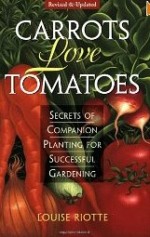 Louise Riotte’s book has been around for a long time and is considered by some to be a classic in the field of companion gardening. With the rising popularity of organic gardening the information set forth in the book is of more interest to gardeners as it contains information that potentially can reduce the need for fertilizer and pesticides. Riotte presents a vast amount of material from ancient to modern sources that makes interesting reading and may provide guidance for more successful gardening.
Louise Riotte’s book has been around for a long time and is considered by some to be a classic in the field of companion gardening. With the rising popularity of organic gardening the information set forth in the book is of more interest to gardeners as it contains information that potentially can reduce the need for fertilizer and pesticides. Riotte presents a vast amount of material from ancient to modern sources that makes interesting reading and may provide guidance for more successful gardening.
The first five chapters of the book treat different plant groups: vegetables, herbs, wild plants, grasses, grains, field crops, fruits, nuts, ornamental trees and shrubs. An assortment of ‘facts’ are given about specific plants including history, cultural techniques, and plants that are good and/or bad companions. We learn that in Italy Jerusalem artichoke are called girasole meaning “turn with the sun”, that most plants do not grow well near fennel, and that sugar beets increases the milk flow in cows. Thistles are rich in potassium and therefore valuable in the compost pile, mulberries can be used to lure birds away from cherries, and poppies rob the soil of nutrients. All of this information is written in an easy, fast flowing style that is interesting as well as informative.
The remaining five chapters include a variety of topics. A chapter on general garden techniques lists topics such as damping-off, frost, and vertical gardening with brief descriptions and the significance of each. A chapter on soil improvement stresses natural ways to put nutrients in the soil, while a chapter on pest control considers biological control of insects and diseases. A chart listing poisonous plants with the plant part that is poisonous is presented and unique garden plans that incorporate the ideas of the book are included with diagrams.
Companion planting is more of an art than a science and Riotte’s book reflects that fact. Riotte is known for her writing on folklore and Carrots Love Tomatoes contains folklore as well as more demonstratable facts. This work is best described as a compendium of information on companion planting with many interesting items in the book to tickle the imagination. There is little, if any, scientific evidence to back up the claims made, but that is not the point of the book. It is an interesting read and may encourage bolder gardeners to experiment with companion planting to find out what works for them.